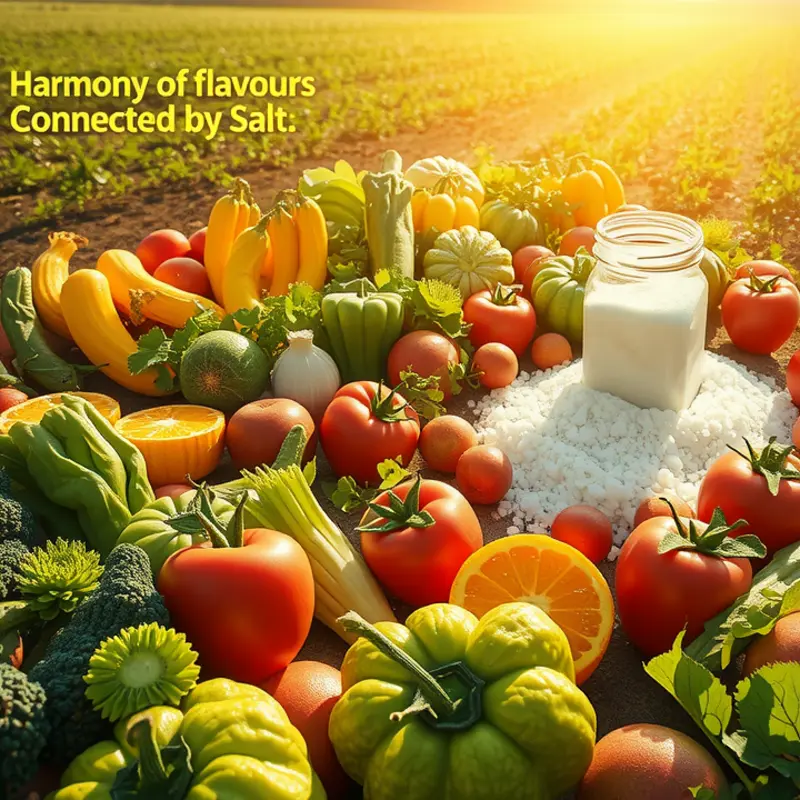Few ingredients evoke such deep-rooted traditions as salt, an essential element in global cuisines. From its ancient uses in preservation to its cultural significance in rituals and culinary arts, salt’s journey is both fascinating and complex. As food enthusiasts and culturally curious readers, exploring the culinary history of salt not only enhances our understanding of flavors but also roots us in a global narrative that transcends time and place. Let’s dive into the past and discover how this humble mineral has shaped cuisines around the world.
Ancient Origins: Salt’s Journey Through Time

Salt, a simple mineral by appearance, has been pivotal in shaping human civilization. Ancient societies, from the Egyptians to the Greeks, understood the unique importance of salt. Its ability to preserve food made it a vital resource in times when refrigeration was inconceivable. The Egyptians, for instance, used salt in the mummification process, recognizing its preservative properties. This practice not only showcased the mineral’s practical uses but also its sacred role in cultural rituals.
The Roman Empire further exemplified salt’s integral role in society. Roman soldiers received a portion of their wages as salt, called ‘salarium,’ a practice which underscores the substance’s substantial value. Salt was so desirable that it spurred the construction of trade routes known as Salt Roads. These paths linked civilizations, facilitating the exchange not only of salt but also of cultural practices and cuisines.
Different types of salt characterized regions and influenced cuisines globally. The Romans favored rock salt, extracted from mines, which contrasted with the Greeks’ preferred sea salt. Sea salt was created by evaporating seawater, a method still prevalent today. Salt flats also contributed distinct flavors to culinary practices, particularly in arid regions where these natural deposits were common. These variations led to a tapestry of flavors and techniques in ancient kitchens.
Salt’s economic significance extended beyond its trade value; it symbolized hospitality and friendship. Sharing salt with a guest was a sign of trust and protection. This symbolism continues today in numerous traditions, where offering bread and salt is a gesture of warm welcome.
The vast network of commerce surrounding salt, epitomized by the Salt Roads, not only facilitated trade but also cultural exchange. Along these routes, ideas, beliefs, and culinary techniques passed from one community to another, creating a shared understanding of the mineral’s importance.
Salt’s multifaceted role throughout history set a precedent for its current standing in culinary practices and conservation efforts. Whether preserving flavors or fostering connections, salt’s journey through time affirms its status as more than just a seasoning.
For more insights into how cultural traditions and food practices intertwine, you might find our exploration of foods used in ancient rituals insightful.
Salt in Culinary Cultures: A Global Mosaic

Salt plays an integral role in culinary traditions across the world, enhancing and preserving flavors in countless ways. Each culture embraces salt’s unique qualities through distinctive dishes and techniques. In Japanese cuisine, the subtlety of umami within a bowl of miso soup demonstrates salt’s ability to highlight the deep flavors of fermented soybeans and seaweed. This dish exemplifies how salt not only seasons but also unlocks the hidden depths of flavor inherent in the ingredients.
Mediterranean culinary practices also showcase salt’s transformative power. The briny taste of olives, often cured with salt, is a staple in this region’s diet. This process not only preserves the fruit but also enriches its natural taste, making it a key ingredient in dishes like Greek salads or Italian tapenade. The curing method, passed down through generations, reveals the cultural significance of salt in maintaining food quality and tradition.
In India, salt is an essential element of the vibrant, complex flavors in curries. Its balanced application intensifies the harmony of spices, highlighting each component of a dish. This precise use of salt enables the symphony of flavors to shine, whether in a rich butter chicken or a tangy vindaloo. Salt not only amplifies taste but also acts as a preservative in age-old practices like pickling, ensuring seasonal vegetables remain a part of the diet year-round.
Globally, methods such as curing, brining, and fermenting underscore salt’s preservative qualities. Scandinavian gravlax demonstrates how curing with salt and sugar creates a delicate, flavorful salmon that is both preserved and enhanced. In Korea, the art of fermenting kimchi relies on salt to facilitate the fermentation process, unlocking tangy flavors that evolve over time. These techniques highlight salt’s role as an invaluable bridge connecting various culinary traditions.
In contemporary cuisine, the artisanal salt movement has emerged, rekindling an appreciation for this ancient ingredient. Today’s chefs and home cooks alike are fascinated by the diverse range of salts available, from Himalayan pink salt to smoked sea salts, each bringing distinct flavors and textures to dishes. This trend echoes a broader culinary shift towards sustainability and respect for natural resources, aligning with ideas explored in this article.
Furthermore, flavored salts have gained popularity as a way to infuse dishes with subtle hints of herbs, spices, or even fruits. These innovations reflect a renewed exploration of salt as more than just a seasoning; they embrace its potential as a fundamental component in the art of cooking. Through traditional and contemporary lenses, salt remains an unseen yet foundational flavor that continues to connect us across the vibrant tapestry of global cuisine.
Final words
Salt is more than just an ingredient; it is a timeless symbol of exchange, cultures, and flavors. From preserving ancient foods to enhancing contemporary dishes, salt has stood the test of time, grounding us in our culinary roots. As we appreciate the historical and cultural significance of this mineral, we are reminded of its power in uniting diverse culinary traditions around the globe. Next time you sprinkle a pinch of salt, remember the rich tapestry it weaves through history and the multitude of flavors it continues to inspire. Celebrate every dish and culture that has grown alongside this remarkable ingredient.








